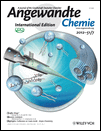Diisobutylaluminum Hydride Mediated Regioselective O Desilylations: Access to Multisubstituted Cyclodextrins†
Dr. Ramprasad Ghosh
Alberta Ingenuity Centre for Carbohydrate Science, Department of Chemistry, University of Calgary, 2500 University Drive NW, Calgary Alberta T2N 1N4 (Canada)
Search for more papers by this authorDr. Ping Zhang
Alberta Ingenuity Centre for Carbohydrate Science, Department of Chemistry, University of Calgary, 2500 University Drive NW, Calgary Alberta T2N 1N4 (Canada)
Search for more papers by this authorDr. Aixia Wang
Alberta Ingenuity Centre for Carbohydrate Science, Department of Chemistry, University of Calgary, 2500 University Drive NW, Calgary Alberta T2N 1N4 (Canada)
Search for more papers by this authorCorresponding Author
Prof. Dr. Chang-Chun Ling
Alberta Ingenuity Centre for Carbohydrate Science, Department of Chemistry, University of Calgary, 2500 University Drive NW, Calgary Alberta T2N 1N4 (Canada)
Alberta Ingenuity Centre for Carbohydrate Science, Department of Chemistry, University of Calgary, 2500 University Drive NW, Calgary Alberta T2N 1N4 (Canada)Search for more papers by this authorDr. Ramprasad Ghosh
Alberta Ingenuity Centre for Carbohydrate Science, Department of Chemistry, University of Calgary, 2500 University Drive NW, Calgary Alberta T2N 1N4 (Canada)
Search for more papers by this authorDr. Ping Zhang
Alberta Ingenuity Centre for Carbohydrate Science, Department of Chemistry, University of Calgary, 2500 University Drive NW, Calgary Alberta T2N 1N4 (Canada)
Search for more papers by this authorDr. Aixia Wang
Alberta Ingenuity Centre for Carbohydrate Science, Department of Chemistry, University of Calgary, 2500 University Drive NW, Calgary Alberta T2N 1N4 (Canada)
Search for more papers by this authorCorresponding Author
Prof. Dr. Chang-Chun Ling
Alberta Ingenuity Centre for Carbohydrate Science, Department of Chemistry, University of Calgary, 2500 University Drive NW, Calgary Alberta T2N 1N4 (Canada)
Alberta Ingenuity Centre for Carbohydrate Science, Department of Chemistry, University of Calgary, 2500 University Drive NW, Calgary Alberta T2N 1N4 (Canada)Search for more papers by this authorWe thank the Alberta Ingenuity (now part of Alberta Innovates–Technology Futures) and the University of Calgary for the financial support of current project. C.C.L. thanks the Canadian Foundation for Innovation and the Government of Alberta for the Leadership Opportunity Award.
Graphical Abstract
A face off: Diisobutylaluminum hydride (DIBAL-H) has been found to be an effective O-desilylating reagent at the primary face of cyclodextrins. This methodology shows high chemo- and regioselectivity and provides an effective route to orthogonally protected, multisubstituted cyclodextrin derivatives.
Supporting Information
Detailed facts of importance to specialist readers are published as ”Supporting Information”. Such documents are peer-reviewed, but not copy-edited or typeset. They are made available as submitted by the authors.
| Filename | Description |
|---|---|
| anie_201105737_sm_miscellaneous_information.pdf10.4 MB | miscellaneous_information |
Please note: The publisher is not responsible for the content or functionality of any supporting information supplied by the authors. Any queries (other than missing content) should be directed to the corresponding author for the article.
References
- 1
- 1aA. R. Khan, P. Forgo, K. J. Stine, V. T. D’Souza, Chem. Rev. 1998, 98, 1977–1996;
- 1bM. Sollogoub, Eur. J. Org. Chem. 2009, 1295–1303;
- 1cE. Engeldinger, D. Armspach, D. Matt, Chem. Rev. 2003, 103, 4147–4173.
- 2
- 2aA. J. Pearce, P. Sinaÿ, Angew. Chem. 2000, 112, 3756–3758;
Angew. Chem. Int. Ed. 2000, 39, 3610–3612;
10.1002/1521-3773(20001016)39:20<3610::AID-ANIE3610>3.0.CO;2-V CAS PubMed Web of Science® Google Scholar
- 2bB. du Roizel, J. P. Baltaze, P. Sinaÿ, Tetrahedron Lett. 2002, 43, 2371–2373;
- 2cT. Lecourt, A. Herault, A. J. Pearce, M. Sollogoub, P. Sinaÿ, Chem. Eur. J. 2004, 10, 2960–2971;
- 2dS. Xiao, M. Yang, P. Sinaÿ, Y. Blériot, M. Sollogoub, Y. Zhang, Eur. J. Org. Chem. 2010, 1510–1516.
- 3aD. Armspach, D. Matt, Carbohydr. Res. 1998, 310, 129–133;
- 3bL. Poorters, D. Armspach, D. Matt, Eur. J. Org. Chem. 2003, 1377–1381;
- 3cD. Armspach, L. Poorters, D. Matt, B. Benmerad, F. Balegroune; L. Toupet, Org. Biomol. Chem. 2005, 3, 2588–2592; L. Toupet, Org. Biomol. Chem. 2005, 3, 2588–2592;
- 3dR. Gramage-Doria, D. Rodriguez-Lucena, D. Armspach, C. Egloff, M. Jouffroy, D. Matt, L. Toupet, Chem. Eur. J. 2011, 17, 3911–3921.
- 4aS. Ward, P. Zhang, C.-C. Ling, Carbohydr. Res. 2009, 344, 808–814;
- 4bG. K. Rawal, S. Rani, C.-C. Ling, Tetrahedron Lett. 2009, 50, 4633–4636;
- 4cG. K. Rawal, S. Rani, S. Ward, C.-C. Ling, Org. Biomol. Chem. 2010, 8, 171–180.
- 5
- 5aN. Masurier, O. Lafont, R. Le Provost, D. Lesur, P. Masson, F. Djedaini-Pilard, F. Estour, Chem. Commun. 2009, 589–591;
- 5bP. Balbuena, D. Lesur, M. J. G. Alvarez, F. Mendicuti, C. O. Mellet, J. M. G. Fernandez, Chem. Commun. 2007, 3270–3272;
- 5cM. Petrillo, L. Marinescu, C. Rousseau, M. Bols, Org. Lett. 2009, 11, 1983–1985;
- 5dR. F. Gómez-Biagi, M. Nitz, Chem. Commun. 2011, 47, 8614–8616.
- 6
- 6aJ. Bjerre, C. Rousseau, L. Marinescu, M. Bols, Appl. Microbiol. Biotechnol. 2008, 81, 1–11;
- 6bR. Breslow, Acc. Chem. Res. 1995, 28, 146–153.
- 7
- 7aC. O. Mellet, J. M. G. Fernandez, J. M. Benito, Chem. Soc. Rev. 2011, 40, 1586–1608;
- 7bA. McMahon, E. Gomez, R. Donohue, D. Forde, R. Darcy, C. M. O’Driscoll, J. Drug Delivery Sci. Technol. 2008, 18, 303–307.
- 8
- 8aJ. M. Haider, Z. Pikramenou, Chem. Soc. Rev. 2005, 34, 120–132;
- 8bT. Ogoshi, A. Harada, Sensors 2008, 8, 4961–4982.
- 9
- 9aG. K. Rawal, P. Zhang, C.-C. Ling, Org. Lett. 2010, 12, 3096–3099;
- 9bH. S. Christensen, B. W. Sigurskjold, T. G. Frihed, L. G. Marinescu, C. M. Pedersen, M. Bols, Eur. J. Org. Chem. 2011, 5279–5290.
- 10
- 10aJ. Boger, D. G. Brenner, J. R. Knowles, J. Am. Chem. Soc. 1979, 101, 7630–7631;
- 10bC.-C. Ling, A. W. Coleman, M. Miocque, Carbohydr. Res. 1992, 223, 287–291.
- 11I. Tabushi, K. Shimokawa, N. Shimizu, H. Shirakata, K. Fujita, J. Am. Chem. Soc. 1976, 98, 7855–7856.
- 12K. Kuranaga, S. Ishihara, N. Ohtani, M. Satake, K. Tachibana, Tetrahedron Lett. 2010, 51, 6345–6348.
- 13
- 13aP. Fügedi, Carbohydr. Res. 1989, 192, 366–369;
- 13bP. Zhang, C.-C. Ling, A. W. Coleman, H. Parrot-Lopez, H. Galons, Tetrahedron Lett. 1991, 32, 2769–2770;
- 13cG. Uccello-Barretta, G. Sicoli, F. Balzano, P. Salvadori, Carbohydr. Res. 2005, 340, 271–281.





